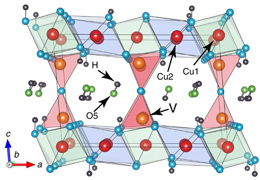Research Abstract
フラストレート磁性体における軌道スイッチング
Orbital switching in a frustrated magnet
2012年5月29日 Nature Communications 3 : 860 doi: 10.1038/ncomms1875

軌道は、スピン、電荷、格子とともに、固体における4つの基本的な自由度の1つである。遷移金属化合物においては、d軌道が結晶学的性質と物理的性質を決めるのに決定的な役割を果たす。今回我々は、スピン1/2擬カゴメ格子反強磁性体ボルボサイトCu3V2O7(OH)2・2H2Oの単結晶において、特異な構造相転移を発見したことを報告する。この相転移では、不対電子の占有する軌道が、あるd軌道から別のd軌道へ「スイッチ」する。これは、通常の軌道秩序無秩序転移ではなく、これまで観測された事のない軌道スイッチング転移である。この構造相転移はボルボサイトの磁気的性質に大きな影響を与えることがわかった。これは、カゴメ格子のCuスピン間の磁気的相互作用が、軌道スイッチングによって大きく変化するためである。今回の知見は、フラストレート磁性体における軌道自由度と、競合する磁気的相互作用の密接で興味深い相関を示している。
- 物質・材料研究機構 強相関物質探索グループ
- 東京大学物性研究所
The orbital is one of the four fundamental degrees of freedom in a solid, besides spin, charge and lattice. In transition metal compounds, it is usually the d orbitals which play deciding roles in determining the crystallographic and physical properties. Here we report the discovery of a unique structural transition in single crystals of the spin-1/2 quasi-kagomé antiferromagnet volborthite, Cu3V2O7(OH)2·2H2O, whereby the unpaired electron 'switches' from one d orbital to another upon cooling. This is not a conventional orbital order–disorder transition, but rather an orbital switching that has not previously been observed. The structural transition is found to profoundly affect the magnetic properties of volborthite, because magnetic interactions between Cu spins in the kagomé lattice are considerably modified by the orbital switching. This finding provides us with an interesting example to illustrate the intimate interplay between the orbital degree of freedom and competing magnetic interactions in a frustrated magnet.

